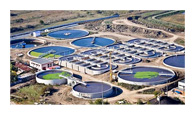
More Products
Quick Inquiry
Waste Water Recycling Treatment Plants
WATER TREATMENT
Industrialization has gone up in urban and semi urban areas by leaps and bounds-especially the power generation units / Textile / Steel and others manufacturing units.
Apart from polluting the atmosphere and water, a stage has come, where the industrialists find it difficulties neither to throw the polluted water, nor can they dispose it off by any other means.
The problem of dumping fly ash has also increased by the power generation units.
To overcome this pessimistic approach of pollution, dumping waste, hazardous and similar negative vibes by the pollution control board, this can be effectively utilized by economic and efficient measure and reused, recycled with optimistic thinking, planning, and execution.
CATALYST INFORMATION
The catalyst is a blend of activated minerals heat treated in reducing atmosphere and agglomerated and again calcined at low temperature to make it a good media to adsorb Iron, Manganese, Cao, Mgo, Alumina and partly dissolved Silica. This works well with 6 to 8 PH in domestic use of well water, underground water not usable as it comes out and from other sources rich in impurities and hardness.
PROCESS
The water is passed through the media (catalyst) (size 4mm to 40mm) with calculated contact time and comes out without the impurities or partly improved. In the latter case it may require recycling or more contact time. The size available is chosen as per the requirement of the input quality and the capacity desired.
BACK WASH
In domestic use the back wash is required once in 6 days or a week.
ABOUT DOMESTIC TREATMENT SYSTEM
The equipment consists of 2 concentric PVC pipes outer of 5” diameter and inner of 1 ½ diameter with length 5 ½ feet. The space between the pipes is filled with the media up to ¾th of the length.
Water percolates from the top (vertical section) through the media and enters through the bottom to the inner pipe and comes out from top- purified.
Minimum capacity is 500 liters/hour, which can be increased to any extent by increasing the contact area and flow of water.
Welding aid manufacturers with acidic effluents of about 1% acidity
This has to be treated before taking in the system. We could do it by treating with NH3-only 500 ML of NH3 was required for 100 liters of effluent.
At the neutral stage (7PH), the iron, silica, alumina precipitates. This can be passed through a filter or permitted to settle and the passed through the media to absorb the impure elements. This can increase the speed of operation without affecting the media.
Action of media (Catalyst) - The media adsorbs the impure elements in Hydroxide form and retains it like a magnet.
PRODUCT DETAILS & SPECIFICATIONS
The product is a blend of activated minerals heat treated in reducing atmosphere and agglomerated and further calcined at low temperature to make a media.
This absorbs Iron, Manganese, CaO, MgO, Alumina and partly dissolved Silica in the RAW WATER/WASTE WATER under supply. It may be used in either gravity fed or pressurized water treatment systems.
The product acts as an insoluble catalyst and works well with water with pH 6-8. In ground waters the dissolved iron is usually in the ferrous bicarbonate state due to the excess of free carbon dioxide and is not filterable. The physical characteristics of the product provide an excellent filter media which is easily cleaned by backwashing to remove the precipitants. The product is not consumed in the iron removal operation and therefore offers economic advantage over many other iron removal methods.
Other advantages of the product include:
- Long material life with relatively low attrition loss.
- Wide temperature performance range (40*C Max).
- Extremely high removal efficiency.
- Negligible labor cost as no other chemical is required for regeneration, only periodic backwashing called for.
If the water is acidic (say 1% acidic needs approximately treatment by NH3-500 ml of NH3 for 100 Liters of water/effluent water).
Weighs only 18 Kg/Cu. Ft.
PHYSICAL PROPERTIES
- Color: Black
- Bulk Density: 18 Kg/c. ft.
- Mesh Size: As desired
- pecific Gravity: 2.0 gm/cc
- Effective Size: As desired
CONDITIONS FOR OPERATION
- Alkalinity should be up to 8.5 Ph
- Maximum water temp: Up to 38*C
- Water pH range: 6.5-9.0
- Bed depth: 3 feet /4 feet
- Freeboard: 60% of bed depth
- Backwash rate: As per size used (approx 30 lit/minute)
INFLUENT AND BACKWASH LIMITATIONS
- Preferably free from chlorine and organics like grease and oil.
OTHER COST EFFECTIVE USE
Usage of this system before RO system enhances the RO system performance greatly.
- The load on RO system is reduced now increasing the efficiency of the purification process.
- Sizing of RO system to have a smaller footprint/complexities.
- Can be effectively used in treatment of waste water released from steel mills, dye industries and other polluting industries releasing waste water.
- By suitable study of the waste water constituents by products like silica gel can be derived in the case of waste water discharges of DYE plants.








